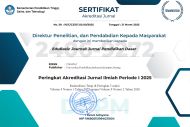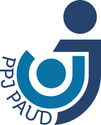Pembelajaran Etnomatematika Sunda untuk Meningkatkan Kemampuan Pemodelan Matematik dan Kecerdasan Kreatif Mahasiswa PGSD
Abstract
Keywords
Full Text:
PDFReferences
Achor, E. E., Imoko, B., & Uloko, E. (2009). Effect of ethnomathematics teaching approach on senior secondary students’ achievement and retention in locus. Educational research and review, 4(8), 385-390.
Arismendi-Pardi, E. J. (2001). Comparison of the final grades of students in intermediate algebra taught with and without an ethnomathematical pedagogy. Presentation to the Center of Diversity in Teaching and Learning in Higher Education, Miami, FL, April 2001. EBSCOHost Academis Search Elite Database
D'Ambrosio, U. (2001). General remarks on ethnomathematics. ZDM, 33(3), 67-69.
Dym, C. L (2004). Principles of Mathematical Modeling. Boston: Elsevier Academic Press.
Harding-De Kam, J. L. (2007). Foundations in ethnomathematics for prospective elementary teachers. School of Teacher Education Faculty Publications, 1, 1-20
Johnson, E. B. (2002). Contextual teaching and learning: What It Is and Why It's Here to Stay. Thousand Oaks, CA: Corwin Press.
Kaiser, G., Blum, W., Ferri, R. B., & Stillman, G. (2011). Trends in teaching and learning of mathematical modelling–Preface. In Trends in teaching and learning of mathematical modelling (pp. 1-5). London: Springer.
Liestiawaty, D. N. (2018). Pemikiran H.R Hidayat Suryalaga tentang Islam-Sunda Tahun 1981-2010. Doctoral dissertation. Bandung: UIN Sunan Gunung Djati Bandung.
Leng, N. W. (2006). Effects of an ancient Chinese mathematics enrichment programme on secondary school students’ achievement in mathematics. International Journal of Science and Mathematics Education, 4(3), 485-511.
Lesh, R. E., & Doerr, H. M. (2003). Beyond constructivism: Models and modeling perspectives on mathematics problem solving, learning, and teaching. Lawrence Erlbaum Associates Publishers.
Massarwe, K., Verner, I., Bshouty, D., & Verner, I. (2010). An ethnomathematics exercise in analyzing and constructing ornaments in a geometry class. Journal of Mathematics and Culture, 5(1), 1-20
Matang, R. A. (2006, February). Linking ethnomathematics, situated cognition, social constructivism and mathematics education: An example from Papua New Guinea. Proceding of ICME-3 Conference Paper (pp. 135-150).
Moller, C. (2005). Creative Intelligence. Diakses Maret 2019 dari laman http://www.openwindows.se/ow2/doc/Claus_M/Creative_Intelligence-CMC[1].pdf
Orey, D., & Rosa, M. (2007). Cultural assertions and challenges towards pedagogical action of an ethnomathematics program. For the Learning of Mathematics, 27(1), 10-16.
Rowe, A. J. (2005). Creative Intelligence: Membangkitkan Potensi Inovasi dalam Diri dan Organisasi Anda. Bandung: Kaifa.
Supriadi. (2014). Mengembangkan Kemampuan dan Disposisi Pemodelan serta Berpikir Kreatif Matematik Mahasiswa PGSD melalui Pembelajaran Kontekstual Berbasis Etnomatematika. Doctoral dissertation. Bandung: Universitas Pendidikan Indonesia.
Supriadi. (2019). Pengaruh pembelajaran inquiry based learning terhadap kemampuan berpikir kritis matematik mahasiswa. Pedagogia, 17(1), 1-12.
Suryadi, D. (2013). Didactical design research (DDR) dalam pengembangan pembelajaran matematika. Prosiding Seminar Nasional Matematika dan Pendidikan Matematika (Vol. 1, pp. 3-12).
Turmudi, H. A. (2014). Pembelajaran matematika dengan pemodelan (mathematical modeling) berbasis realistik untuk mahasiswa. Jurnal Pengajaran Matematika dan Ilmu Pengetahuan Alam (JPMIPA), 19(1), 1-18
DOI: https://doi.org/10.17509/ebj.v1i1.26223
Refbacks
- There are currently no refbacks.
Copyright (c) 2019 Universitas Pendidikan Indonesia
This work is licensed under a Creative Commons Attribution 4.0 International License.
This journal is indexed by




.png)




.png)
1.png)


1.png)

.png)